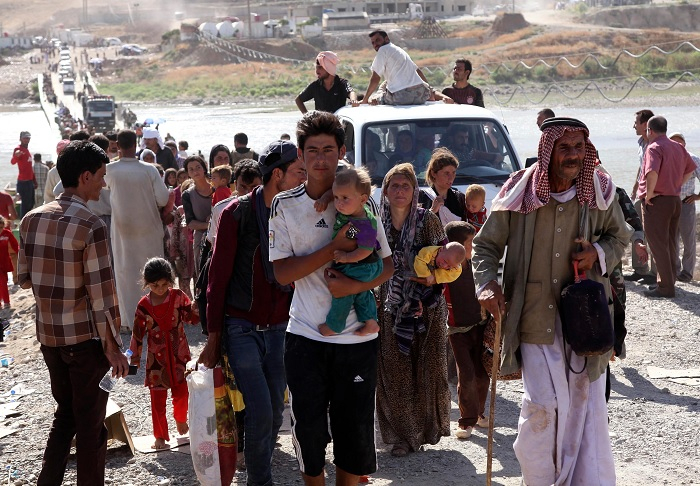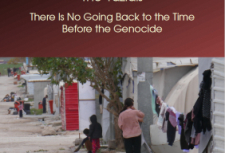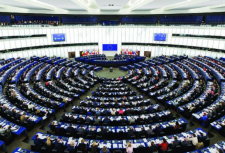The plight of the surviving Yezidis continues to this day

The absolute goal of the ISIS terrorist group was not only to control the land and spread terror, but also to destroy the Yezidi minority in the interests of the caliphate they were creating.
The ruthless genocide campaign of 2014 to destroy the Yezidi culture was carried out by terrorists through a system of sexual slavery in which women were regularly sold and abused in the most brutal ways.
The highest religious authority of the Yezidis, Hurto Haji Ismael, also known as Baba Sheikh, reacted to the brutal actions of the IS against the community and made an unprecedented call for family reunification on February 6, 2015, stating that all Yezidis who were forced to join the IS, both men and women, remain unsullied and should be accepted back into society after they were rescued from the captivity of a terrorist group.
IS controlled areas of Iraq and Syria in 2014, but suffered territorial defeat in 2017 and 2019, respectively. However, this did not put an end to the problems of the Yezidis.
While Yazidi survivors live in camps for internally displaced persons (IDPs), which lack basic daily needs, many IS members and suspects live comfortably in Europe and other countries around the world.
Survivors of ISIS captivity, Yazidi activists and individuals have done a great job for society. However, much more needs to be done to find those who are still missing.
In April 2019, the Supreme Spiritual Council of the Yezidis issued a more important, albeit short-lived decree, which stated that the community would accept children born to mothers raped by IS militants to open the way for hundreds of women to return home.
Theologically, Yezidism is an endogamous faith that requires its members to marry within their community, but the decree issued by the Supreme Spiritual Council of Yezidis was based on humanitarian considerations.
However, under pressure from Yazidi traditionalists and political groups, the decree was canceled three days later – the surviving women and children abducted by the militants were accepted back into the community, but there was no place for children whose fathers were members of ISIS.
This left the women intending to return home with a harsh choice: abandon their children or remain in eternal exile. Apparently, the genocide of the Yezidis continues.
Statistics on the number of abducted and returned are available at the Department for Abducted Yezidis in Dahuk, however, without knowing the exact number of Yezidis killed by ISIS, it is impossible to know the exact number of those who are still missing.
It is assumed that many of the missing, especially older men and boys, died. Others, mostly women, are still being held captive in Syria. It is believed that hundreds of people are being held in the al-Khol camp, which is run by the Kurdish-led Syrian Democratic Forces (SDF).
But the question arises, why do Yezidi girls and women refuse to reveal their identity and prefer this new medieval way of life to the prospect of starting a new life in another country? There are two main reasons for this:
First, most of the girls were abducted when they were about four or five years old and have been indoctrinated by ISIS for the past seven years. Forcibly displaced, many of them have forgotten that they are Yezidis.
ISIS has turned children against their culture, tearing them away from their families and relatives. The jihadists had a significant impact on them, and they were brainwashed because they spent their first and crucial years of life under the rule of the so-called caliphate.
For the specific purpose of destroying the Yezidis, the IS militants resettled the captured Yezidis as far as possible from their homeland to different parts of Iraq and Syria. They took them to areas where IS ideologists and Sharia law lawyers lectured that the Yezidis were “infidels” and that they would not be accepted into the community if they returned.
The profound psychological impact of eight years of captivity and the loss of family members is felt in society. The rising suicide rate is one of the signs of how difficult it is for returnees to reintegrate.
Mothers do not want to abandon their children because they are well aware of the taboo that has engulfed the community, which rejects marriage with non-Yezidis. Rape and insemination by non-Yezidis is seen as a serious blow to the Yezidi lineage.
The public and brutal stoning to death of Du'a Khalil Aswad in 2007 evokes memories. Khalil ran away with a Muslim and converted to Islam.
Segregation between mother and child is a huge stumbling block to the full reintegration of Yazidis. Mothers were falsely told that they would be allowed to visit their loved ones, but they never dared to talk about them.
There are several exceptional cases when mothers abandoned their children because they considered them an unbearable reminder of abuse and rape by IS members. However, the vast majority do not want to leave their flesh behind.
The commodification of Yazidi women and girls has left scars on both individuals and the community. Some women and girls were sold and resold individually or collectively. Such inhumane acts were committed strategically in order to destroy an individual and tear a religious group apart.
Physically and emotionally traumatized by long years of abuse, they seem unable to undergo a new transformation. Psychologically, these women are broken, and culturally they are rejected.
After a lengthy debate, the Iraqi parliament passed a law in March 2021 that legally recognizes the crimes of ISIS against the Yezidis as genocide and obliges, among other things, to ensure a decent life for the surviving women.
The innovative, pompous law was too narrow to meet the needs of the people in question, in particular, the fate of children born of IS militants.
It is striking that in the same month, nine Yazidi mothers were reportedly reunited with their twelve children who were in an orphanage in Syria. A secret operation was carried out at the Syrian-Iraqi border checkpoint Feishhabur-Semalka.
It seems strange, though, that after many years of family loss and dismemberment, many Yazidi girls and women now feel the comfort and protection of a new culture they have reluctantly entered and do not want to leave it.
Lazgine Yakube is a translator and researcher specializing in the modern history of Mesopotamia, with a special focus on Yezidi and Assyrian affairs in Syria and Iraq.
Tags: #ezidi #sindjar #shangal #ezidxan #yezidis #yazidis
The plight of the surviving Yezidis continues to this day

The absolute goal of the ISIS terrorist group was not only to control the land and spread terror, but also to destroy the Yezidi minority in the interests of the caliphate they were creating.
The ruthless genocide campaign of 2014 to destroy the Yezidi culture was carried out by terrorists through a system of sexual slavery in which women were regularly sold and abused in the most brutal ways.
The highest religious authority of the Yezidis, Hurto Haji Ismael, also known as Baba Sheikh, reacted to the brutal actions of the IS against the community and made an unprecedented call for family reunification on February 6, 2015, stating that all Yezidis who were forced to join the IS, both men and women, remain unsullied and should be accepted back into society after they were rescued from the captivity of a terrorist group.
IS controlled areas of Iraq and Syria in 2014, but suffered territorial defeat in 2017 and 2019, respectively. However, this did not put an end to the problems of the Yezidis.
While Yazidi survivors live in camps for internally displaced persons (IDPs), which lack basic daily needs, many IS members and suspects live comfortably in Europe and other countries around the world.
Survivors of ISIS captivity, Yazidi activists and individuals have done a great job for society. However, much more needs to be done to find those who are still missing.
In April 2019, the Supreme Spiritual Council of the Yezidis issued a more important, albeit short-lived decree, which stated that the community would accept children born to mothers raped by IS militants to open the way for hundreds of women to return home.
Theologically, Yezidism is an endogamous faith that requires its members to marry within their community, but the decree issued by the Supreme Spiritual Council of Yezidis was based on humanitarian considerations.
However, under pressure from Yazidi traditionalists and political groups, the decree was canceled three days later – the surviving women and children abducted by the militants were accepted back into the community, but there was no place for children whose fathers were members of ISIS.
This left the women intending to return home with a harsh choice: abandon their children or remain in eternal exile. Apparently, the genocide of the Yezidis continues.
Statistics on the number of abducted and returned are available at the Department for Abducted Yezidis in Dahuk, however, without knowing the exact number of Yezidis killed by ISIS, it is impossible to know the exact number of those who are still missing.
It is assumed that many of the missing, especially older men and boys, died. Others, mostly women, are still being held captive in Syria. It is believed that hundreds of people are being held in the al-Khol camp, which is run by the Kurdish-led Syrian Democratic Forces (SDF).
But the question arises, why do Yezidi girls and women refuse to reveal their identity and prefer this new medieval way of life to the prospect of starting a new life in another country? There are two main reasons for this:
First, most of the girls were abducted when they were about four or five years old and have been indoctrinated by ISIS for the past seven years. Forcibly displaced, many of them have forgotten that they are Yezidis.
ISIS has turned children against their culture, tearing them away from their families and relatives. The jihadists had a significant impact on them, and they were brainwashed because they spent their first and crucial years of life under the rule of the so-called caliphate.
For the specific purpose of destroying the Yezidis, the IS militants resettled the captured Yezidis as far as possible from their homeland to different parts of Iraq and Syria. They took them to areas where IS ideologists and Sharia law lawyers lectured that the Yezidis were “infidels” and that they would not be accepted into the community if they returned.
The profound psychological impact of eight years of captivity and the loss of family members is felt in society. The rising suicide rate is one of the signs of how difficult it is for returnees to reintegrate.
Mothers do not want to abandon their children because they are well aware of the taboo that has engulfed the community, which rejects marriage with non-Yezidis. Rape and insemination by non-Yezidis is seen as a serious blow to the Yezidi lineage.
The public and brutal stoning to death of Du'a Khalil Aswad in 2007 evokes memories. Khalil ran away with a Muslim and converted to Islam.
Segregation between mother and child is a huge stumbling block to the full reintegration of Yazidis. Mothers were falsely told that they would be allowed to visit their loved ones, but they never dared to talk about them.
There are several exceptional cases when mothers abandoned their children because they considered them an unbearable reminder of abuse and rape by IS members. However, the vast majority do not want to leave their flesh behind.
The commodification of Yazidi women and girls has left scars on both individuals and the community. Some women and girls were sold and resold individually or collectively. Such inhumane acts were committed strategically in order to destroy an individual and tear a religious group apart.
Physically and emotionally traumatized by long years of abuse, they seem unable to undergo a new transformation. Psychologically, these women are broken, and culturally they are rejected.
After a lengthy debate, the Iraqi parliament passed a law in March 2021 that legally recognizes the crimes of ISIS against the Yezidis as genocide and obliges, among other things, to ensure a decent life for the surviving women.
The innovative, pompous law was too narrow to meet the needs of the people in question, in particular, the fate of children born of IS militants.
It is striking that in the same month, nine Yazidi mothers were reportedly reunited with their twelve children who were in an orphanage in Syria. A secret operation was carried out at the Syrian-Iraqi border checkpoint Feishhabur-Semalka.
It seems strange, though, that after many years of family loss and dismemberment, many Yazidi girls and women now feel the comfort and protection of a new culture they have reluctantly entered and do not want to leave it.
Lazgine Yakube is a translator and researcher specializing in the modern history of Mesopotamia, with a special focus on Yezidi and Assyrian affairs in Syria and Iraq.
Tags: #ezidi #sindjar #shangal #ezidxan #yezidis #yazidis

























